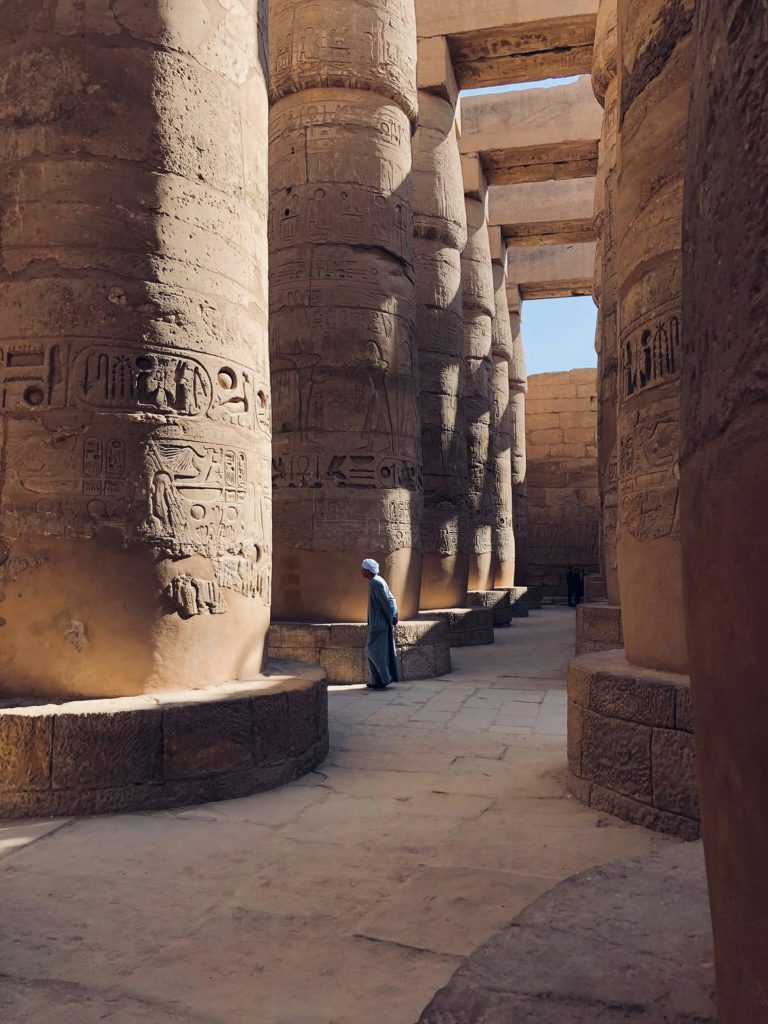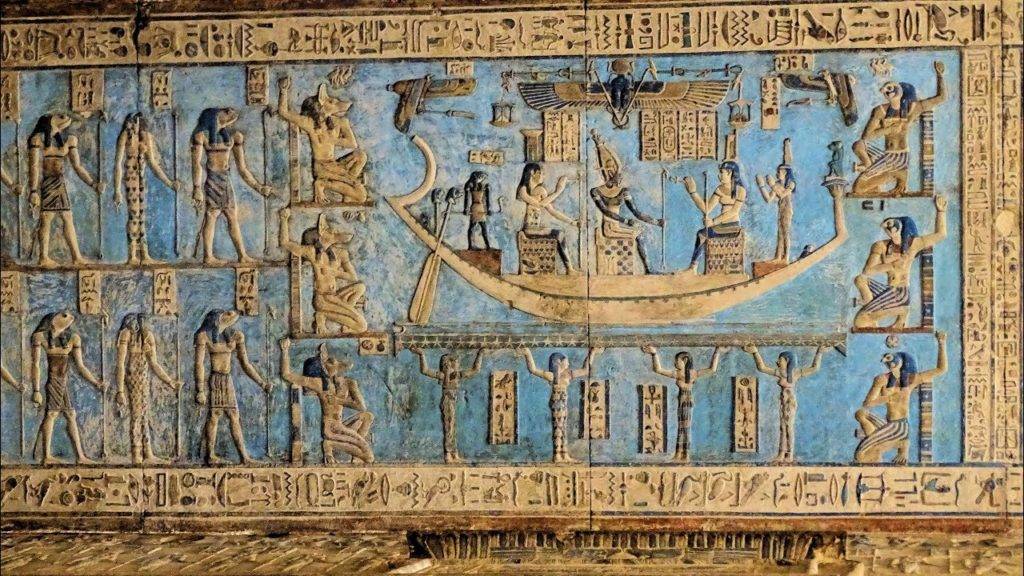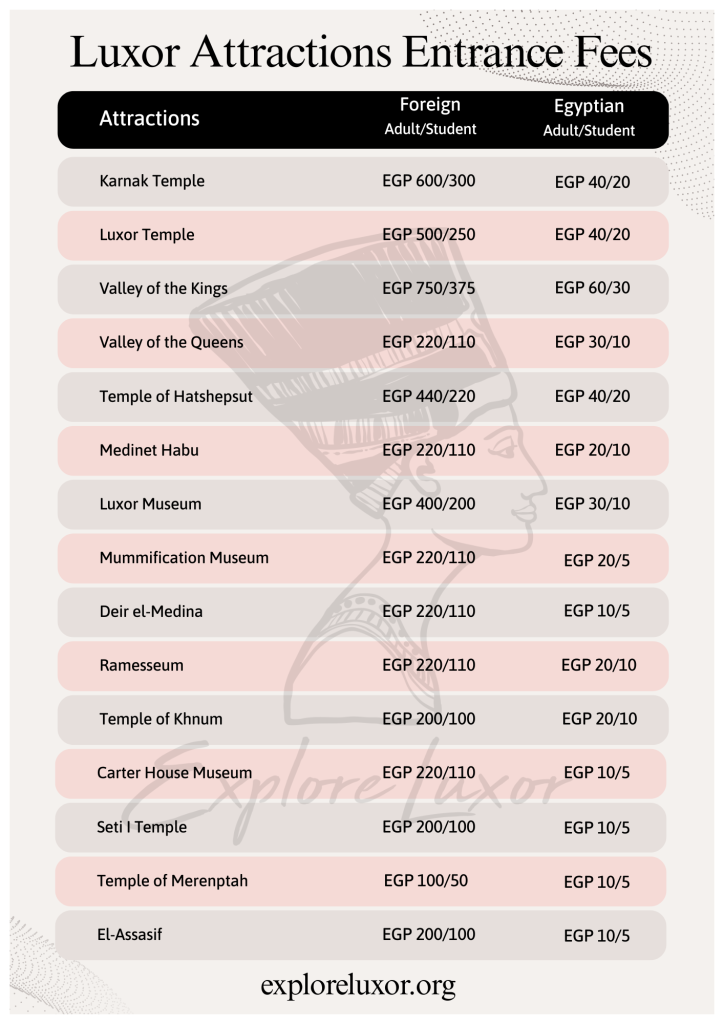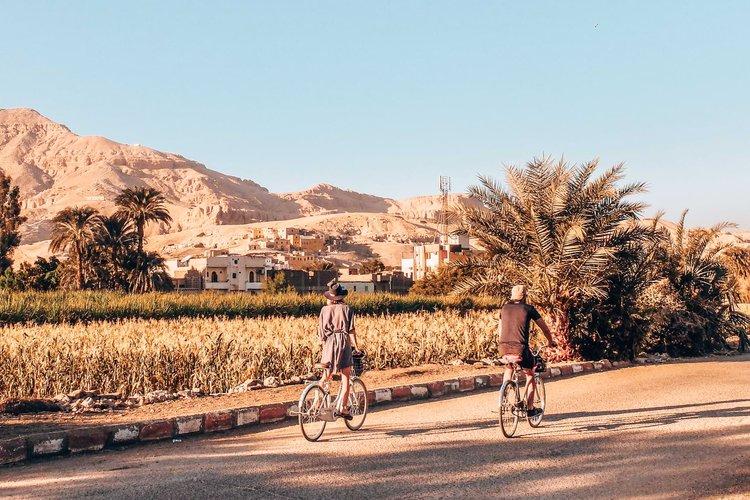Things to Do in Luxor
A Complete Travel Guide
Luxor is a unique city that serves as a living museum. Once known as ancient Thebes, it was the center of Egypt’s New Kingdom, where pharaohs ruled, temples thrived, and tombs were carved into desert cliffs. Today, Luxor is one of the world’s most amazing travel destinations, blending rich history with lively modern life. You can float above the Nile in a hot air balloon at sunrise, explore grand temples that kings once visited, or haggle for spices in busy markets. Luxor offers moments that feel timeless, with every corner telling a story.
This guide highlights the best things to do in Luxor. It combines history with practical tips to help you plan an unforgettable trip.

East Bank Highlights: The Heart of Ancient Thebes
The Nile River splits Luxor into two parts: the East Bank, known as the “Land of the Living,” and the West Bank, called the “Land of the Dead.” Each side has its own attractions that require separate tickets. The city has several ticket offices, each for a specific purpose. Knowing which office to go to helps you save time, avoid confusion, and ensures you don’t miss special experiences like the Sound & Light show or the exclusive tombs of Seti I and Nefertari.
Luxor Tours & Activities
Looking to save some costs on your travel? Why not join a shared group tour to explore Luxor, Egypt? Here are some activities you might be interested in:

Karnak Temple Complex
Karnak is the largest religious site ever built, primarily dedicated to Amun-Ra. The Great Hypostyle Hall, with its 134 towering columns, transports you to another world. The Sound and Light Show at night brings its myths to life with dramatic narration.

Luxor Temple
Dedicated to kingship, Luxor Temple was built by Amenhotep III and expanded by Ramses II. It’s the ceremonial center of the Opet Festival, where god statues are paraded. At night, the temple glows beautifully, enhancing the atmosphere and revealing the stories in its carvings. The restored Avenue of Sphinxes now connects Luxor to Karnak.

Luxor Museum
For a closer look at Egypt’s treasures, the Luxor Museum is a must. With a curated collection of New Kingdom statues, exquisite jewelry, and royal mummies, it offers a more intimate experience than Cairo’s larger Egyptian Museum.
The East Bank combines ancient grandeur with the vibrancy of modern Egyptian life, offering easy access to restaurants, hotels, and transport.

West Bank Wonders: Tombs and Temples of the Afterlife
Crossing the Nile to Luxor’s West Bank feels like entering another dimension, known in ancient times as the realm of the dead. This area is home to the tombs and monuments of Egypt’s greatest pharaohs, showcasing a civilization obsessed with eternity.

Valley of the Kings
The legendary Valley of the Kings houses over 60 tombs carved into the rock, designed to guide pharaohs into the afterlife. The most famous tomb is that of Tutankhamun, discovered in 1922. Notable others include Ramses VI’s tomb, with its stunning celestial ceiling, and Seti I’s, celebrated for its vibrant colors. Arriving early is advisable to avoid crowds and gain access to exclusive tombs.

Temple of Hatshepsut
The Temple of Hatshepsut is a striking mortuary temple built for Egypt’s most successful female pharaoh. Its terraces and colonnades blend beautifully with the limestone cliffs, while reliefs inside depict Hatshepsut’s divine birth and her journey to the Land of Punt.

Valley of the Queens
This smaller valley features the breathtaking tomb of Queen Nefertari, often referred to as the “Sistine Chapel of Ancient Egypt” due to its vibrant artistry. Access is limited and requires a special ticket, but the experience is unforgettable.

Medinet Habu
Often overlooked, Medinet Habu is a well-preserved temple of Ramses III, adorned with vivid reliefs depicting battles and daily life. Its less crowded atmosphere allows for a reflective visit.
To explore the vast West Bank, hiring a guide or driver is recommended. Many visitors combine trips to the Valley of the Kings, Hatshepsut’s temple, and Medinet Habu in one day, leaving time for evening activities like a felucca ride or market stroll.

Unique Experiences Beyond the Monuments
Luxor has more to offer than just temples and tombs. You can enjoy experiences that connect you with the local culture and beautiful landscapes.
Hot Air Balloon Ride Over Luxor: Picture yourself drifting above the Nile at sunrise, as you see temples and fields glowing in the morning light.
Felucca Ride on the Nile: Take a ride on a traditional wooden sailboat to relax after a day of exploring.
Local Souk and Markets: Stroll through stalls filled with spices, handmade crafts, and vibrant textiles. Bargaining is part of the fun.

Day Trips from Luxor
Luxor is a great place to start exploring nearby attractions:
Dendera Temple Complex: About 60 km north of Luxor, Dendera is known for the Temple of Hathor. Its ceiling has one of the most detailed astronomical carvings in Egypt.
Abydos Temple: Roughly 135 km from Luxor, Abydos features the Temple of Seti I, which has some of the best-preserved reliefs in Egypt.
Edfu Temple: Dedicated to Horus, Edfu is one of the best-preserved temples in Egypt and sits between Luxor and Aswan.
Kom Ombo: This unique double temple is dedicated to Sobek, the crocodile god, and Horus. It’s often visited on the way to Aswan.
Adding one or two of these day trips to your itinerary helps you learn more about Egypt’s temple architecture and mythology.

Luxor at Night: Evening Magic
Luxor offers amazing experiences after sunset that are just as captivating as daytime sightseeing:
- Luxor Temple Illuminated: Visit the temple at night to see it glowing in golden light. It’s an unforgettable experience.
- Sound and Light Show at Karnak: Enjoy a dramatic show that tells Egypt’s history on the walls of Karnak.
- Felucca Sunset Cruise: Take a boat ride along the Nile as the sky changes to beautiful shades of red.
- Dining Experiences: Try traditional Egyptian food at popular places like Sofra Restaurant and Al-Sahaby Lane. Rooftop dining along the Nile provides great views.
- Winter Palace Terrace: Sip cocktails where Agatha Christie once stayed, surrounded by charming colonial style.

Ticketing & Logistics: How to Explore Smartly
Luxor Pass: Available in two versions:
Standard Pass: Covers most sites in Luxor (East and West Bank).
Premium Pass: Includes all sites plus entry to Tutankhamun’s tomb.
Individual Tickets: If you don’t buy the pass, tickets are sold at each site. Prices vary, with premium tombs requiring extra fees.
Practical Travel Tips for Luxor
Best Time to Visit: October–April offers cooler weather, perfect for exploring. Summers can be extremely hot.
Getting Around: Taxis, horse carriages, and ferries are common. For flexibility, consider hiring a guide with transport included.
Suggested Itineraries:
2-Day Stay: East Bank on day one, West Bank on day two.
4-Day Stay: Add balloon rides, felucca cruises, and Esna for a deeper experience.

Where to Stay in Luxor
Luxury: The Winter Palace, where Agatha Christie once stayed, is steeped in history. Hilton Luxor Resort & Spa offers modern comforts with Nile views.
Mid-Range: Hotels along the Nile provide great value and easy access to attractions.
Budget: Guesthouses on the West Bank offer affordable stays and a chance to experience local hospitality.

Food and Dining in Luxor
Egyptian cuisine is hearty, flavorful, and worth exploring:
Traditional Dishes: Try koshari (a mix of pasta, rice, and lentils), molokhia (green soup), and grilled kofta.
Restaurants with Views: Many Nile-side restaurants serve Egyptian and international dishes with stunning scenery.
Street Food: Falafel from local stalls are delicious and budget-friendly.
Got a Question?
F.A.Qs
Yes, Luxor is considered one of Egypt’s safest destinations for travelers. Tourism is a major part of the local economy, so there’s a strong police presence and locals are welcoming. As with any destination, use common sense—stick to well-lit areas at night and be cautious with valuables.
Two days is enough to see the East and West Bank highlights. However, three to four days allow you to add unique experiences like a hot air balloon ride, a felucca cruise, and day trips to Dendera or Abydos.
Absolutely. If you plan to visit multiple tombs and temples, especially premium sites like Tutankhamun’s tomb, the Luxor Pass saves money and time. It comes in two versions: Standard (most sites) and Premium (includes Tutankhamun).
October through April is ideal, with cooler weather for sightseeing. Summer months can be extremely hot, often exceeding 40°C, making outdoor exploration challenging.
Yes! Luxor Temple is stunning when illuminated, Karnak hosts a Sound and Light Show, and felucca cruises at sunset are magical. Dining at rooftop restaurants or the Winter Palace terrace adds to the evening charm.
Did you know that
By purchasing through our links, you support us at no additional cost.
Thank you for your support. ♥️






